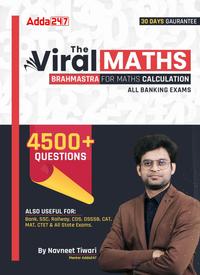Directions (1-3): The following questions are accompanied by two statements (I) and (II). You have to determine which statements(s) is/are sufficient/necessary to answer the questions.
(a) Statement (I) alone is sufficient to answer the question but statement (II) alone is not sufficient to answer the question.
(b) Statement (II) alone is sufficient to answer the question but statement (I) alone is not sufficient to answer the question.
(c) Both the statements taken together are necessary to answer the question, but neither of the statements alone is sufficient to answer the question.
(d) Either statement (I) or statement (II) by itself is sufficient to answer the question.
(e) Statements (I) and (II) taken together are not sufficient to answer the question.
Q1. There are three articles A, B and C. Find the cost price of article B?
I. Marked price of B & C is same. Shopkeeper allowed 10% discount on C and cost price of C is Rs.250. Ratio of profit earned to discount allowed on B & C is 3 : 5 and 2 : 3 respectively.
II. Ratio of cost price of A to that of B is 8 : 3. Shopkeeper incurred a loss of 12.5% on A and selling price of A is Rs.195 more than selling price of B.
Q2. A man invested Rs.5P, Rs.7P and Rs.4P in schemes A, B & C respectively. Schemes – A & C offers CI and scheme B offers SI. Find value of P.
I. Ratio of period of investment in scheme A and B is 2 : 3 and rate of interest offered by scheme A is 2% more than that offered by scheme B. Total interest received by the man from schemes A & B together is Rs.2,32,704.
II. Amount received from scheme B is Rs.1,66,860 more than that received from scheme C. Rate of interest offered by scheme C is 15% p.a. and period of investment in scheme B is thrice of period of investment in scheme C.
Q3. In a box three types of balls are there Black, Red and White. If number of white balls is given, then find out the probability of getting one white ball.
I. Probability of getting one red ball is given.
II. Probability of getting one black ball is given.
Directions (4-5): Each of the following question is followed by two quantities I, and II. You have to determine the value of the quantities using the information provided and accordingly compare the quantities. Mark your answer as per the instruction set provided below.
(a) Quantity I>Quantity II
(b) Quantity I≥Quantity II
(c) Quantity I<Quantity II
(d) Quantity I≤Quantity II
(e) Quantity I=Quantity II or no relation
Q4. Quantity I: Time taken by Prabhas to cover a distance of 200 km (without stoppage) by car through which he covers a distance of 100 km in 1 hour when he stops to get fuel for 10 minutes.
Quantity II: Time taken by Nagarjuna to travel 20 km downstream if speed of boat and speed of stream be 7 kmph & 3 kmph respectively.

Solutions




. . . .











 Quantitative Aptitude Quiz For Bank Main...
Quantitative Aptitude Quiz For Bank Main...
 Quantitative Aptitude Quiz For Bank Foun...
Quantitative Aptitude Quiz For Bank Foun...





